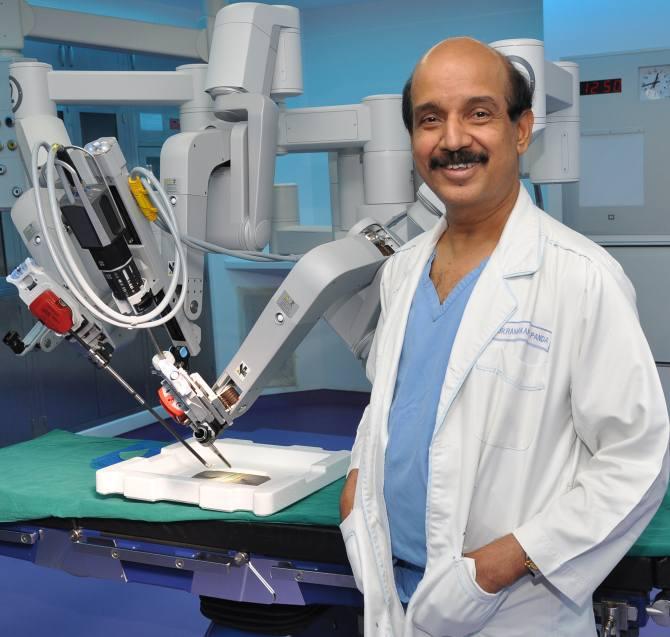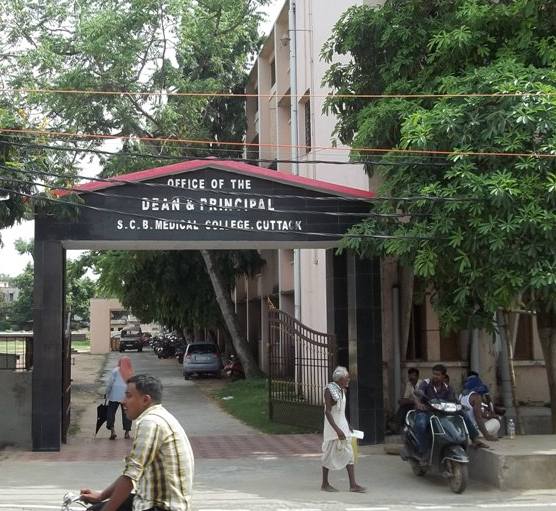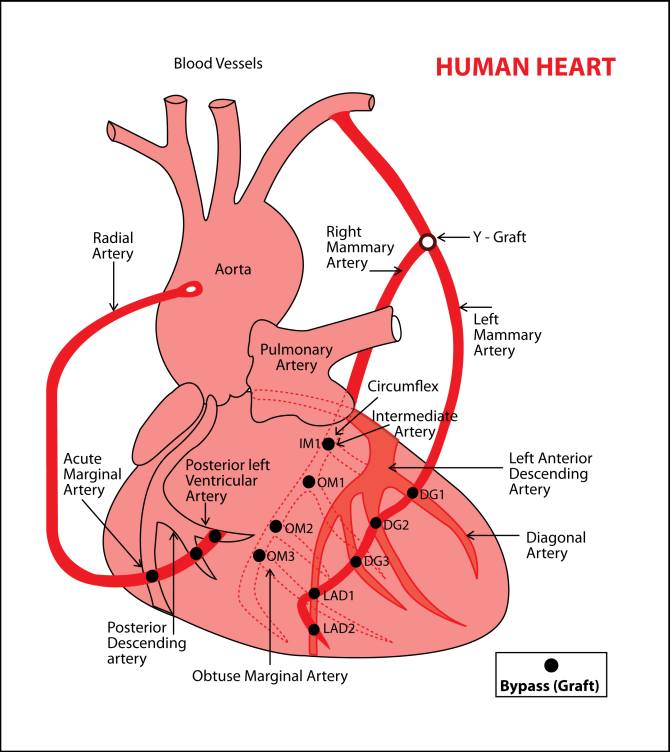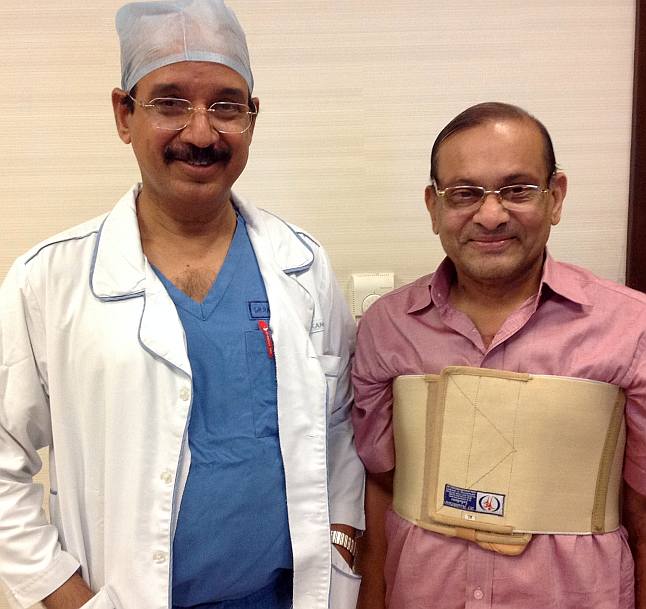
He was born in a village in Odisha.
Today, Dr Ramakant Panda -- who has performed more than 18,000 heart operations including one on the prime minister and built a world-class hospital -- is considered one of the best cardiac surgeons in the world.
Rediff.com's Prasanna D Zore on Dr Panda's incredible story:
Growing up in the 1960s in Odisha in a village that did not attach much premium on getting educated, Dr Ramakant Panda is considered one of the best cardiac surgeons in the world today.
He has performed over 18,000 cardiac surgeries, 3,000 of them in the high-risk category, 1,000 redo bypass surgeries, including one on Prime Minister Manmohan Singh on January 24, 2009.
"The biggest challenge was to keep away from getting astray," Dr Panda recalls his childhood in Damodarpur in Odisha's Jashpur district.
Dr Panda -- vice-chairman and managing director of one of India's best cardiac care hospitals, Mumbai's Asian Heart Institute which recently treated its 200,000th patient -- credits his parents, his grandfather and his school headmaster for his success.
"All these people prevented me from going astray and help me become what I am today," he says.
Always a brilliant student Dr Panda credits his maternal uncle for inspiring him to become a doctor. "My mama was a doctor, a pretty successful doctor. He retired as the Director General Medical Services in the Indian armed forces. He was my inspiration."
How did he not go astray? Dr Panda recalls two incidents from his childhood that left its indelible impression on him.
Once he played truant from school to play gulli danda for five days, but was caught out by his mother and headmaster.
"I got the beating of my life from my mother and for more than eight hours she locked me in a room and didn't give me any food," he says, recalling how strict his mother was.
Later, as a 14-year-old preparing for his board exams after rigorous hours of study, Dr Panda and his friends would sneak out to watch movies from 9 to 12 at night to Jashpur from Damodarpur -- a distance of 18 km -- on bicycles and come back by 2 in the morning to the school hostel without the headmaster getting any scent of it.
Luck again deserted him.
Being the most brilliant student in class, the headmaster made him kneel in the scorching sun for three hours.
"That was the most humiliating event in my life, something that brought about a major change in my life."
"After that I never indulged in such childish acts. I grew up much faster."
"Overnight I became an adult."
Dr Panda went on to study medicine at the All India Institute of Medical Sciences in New Delhi and from there on to the Cleveland Clinic, perhaps the finest heart care hospital in the world.
In this interview with Rediff.com, Dr Panda tells Prasanna D Zore about the milestones in his life, his role models, success mantras, his love for the Hilsa fish and how he built the Asian Heart Institute from scratch.
What has Mumbai done for Dr Ramakant Panda? Tell us about your bond with this city...
Mumbai has done everything for me. I don't think I would have succeeded as I have succeeded anywhere else.
A great team is always very crucial for any successful venture. Tell us about your team building efforts...
When I came back from the US, I was going from hospital to hospital; I had that burning desire to put up a hospital. So wherever I found good, sincere, hard working people I started cultivating them and saw to it that they became a part of my team. And those people have been there with me from the last 20 years.
Our teamwork is excellent and one of the keys to the success of Asian Heart is teamwork.
Kindly click NEXT for more on Dr Panda's amazing life...

Growing up...
I grew in Damodarpur which is about 15 km from the district headquarters Jashpur in Odisha. Though there was a high school just a kilometre away from my home we went to another school, about 8 km away, because that was the best school in our area.
My brother, my sister and I, all decided, that we would study at the Benod Behari High School.
We would walk 7 km every day back and forth. We did that for six years.
After that I did my college from the Sriram Chandra Bhanja Medical College, Cuttack. It was then the best medical college in Odisha and one of the oldest in the country dating back to 1869.
Later I went to AIIMS, did my cardiac surgery training and from there I went to the Cleveland Clinic that was, and even today, is the best cardiac care centre in the world.
I worked there for close to eight years. It was a really fruitful experience for me because there I saw the best results and patient care in the world.
There I realised that it was not just your own excellence and brilliance that succeeds, but more importantly teamwork and a very robust system process. That is what made the place so good.
It is not just because they have the best doctors but because of a great team and system processes. That's what I learnt there; I wanted to replicate a similar system in India. So, I came back, it took us eight years, but we succeeded in benchmarking ourselves against the best in the field.
Challenges faced as a child...
The biggest challenge was to keep away from getting astray and spoiled. There was always peer pressure. I grew up in a village and education then was not considered a very big thing.
To see your friends not studying and you studying and then (not getting tempted to be like them) was a big challenge.
Role models
I had fantastic parents; my grandfather was a freedom fighter and principal of one of the schools in Jashpur. He died before I could go to high school. But he had a significant influence on me.
My high school headmaster Satish Chandra Das was a really good man and he too had a significant influence on my childhood.
I was his most favourite student. Whenever I would go to Odisha I made it a point to meet him. Even on his deathbed he wanted to see me.
Unfortunately, I was stuck in Mumbai in an emergency and he passed away suddenly. When he got admitted to an ICU in Bhubaneshwar he was looking for me.
I came to know about his wish in the daytime and I promised him that I would be there the next morning.
But he died the same night.
I think all these people prevented me from going astray and become what I am today.
Values learnt from parents...
Hard work, honesty, sincerity.
Family's role in success
My mother was a very strict disciplinarian. Everybody in the hospital thinks I am too strict, but that is what I learnt from my mother and grandfather as a child.
The environment when I was growing up in my village was not very conducive for learning; nobody in my village gave much importance to studies.
Though my grandfather was very fond of me, he was a strict disciplinarian. He did not let me go astray. After my grandfather's death I stayed with my mother who was equally strict.
My high school headmaster was also a taskmaster.
Kindly click NEXT for more on Dr Panda's amazing life...

Inspiration to become a doctor
My mama was a doctor, a pretty successful doctor. He was my inspiration.
In 1967 when Dr Christian Barnard performed the first heart transplant I was in Class IX. Dr Denton Cooley, who performed the first heart transplant in the US, was profiled in Life magazine, one of the most prestigious magazines then.
When I read that interview I realised I too wanted to become a heart surgeon though I had no idea how to become one and what kind of hard work it required.
These small things influenced my life and shaped my career and me as a person.
Even at that time the Cleveland Clinic was the best place for training and all the innovations in cardiac care were taking place there.
By the time I trained under Dr Cooley for a month he was at the fag end of his career.
Life lessons
People might consider these as old-fashioned values, but I cherish hard work, integrity and honesty and that is what is the secret of my success.
Apart from value systems, I also learned empathy and doing something for the less privileged from my life.
Advice to India's youth...
Aim for the sky; don't aim for small things in life. If you aim for the sky, you will at least climb half as high.
Aim for the best you can achieve in your field and then work towards it.
Value system still has a very big role to play in your success. Use this value system as your guide to take you sky-high.
People respect those who are sincere with their value systems.
Motivation
I have done 18,000 operations, one of the highest in the world. Dr Denton Cooley has, I think, done the highest at 30,000 operations or perhaps more than that.
Recently, we operated on a patient who had 12 bypass grafts. That definitely is the first-of-a-kind bypass surgery. The highest done so far as per our research is eight grafts.
Two years ago I did 10 grafts on a person. We are applying to the Guinness Book of World Records to acknowledge our record.
This man, who is originally from Karnataka, underwent an angiography in Hyderabad where he was told he was inoperable because his arteries are very, very small and there is no major artery to bypass.
When he came here, he was in a very critical condition; we had to use a balloon pump to support his blood pressure because he was almost in dying condition.
We did 12 bypasses on him; then we did his angiogram before he got discharged. All the grafts were working fine and then after three weeks we did his stress test and found that his heart pumping function, which was 25 per cent before the bypass, had improved to 45 per cent.
This is the greatest satisfaction a man like me can get to help a person who is almost dying to recover and lead a normal life in just about three weeks.
That's what keeps me kicking; that is my drive.
How do you keep your heart fit?
What kind of fitness regimen do you follow to keep your heart healthy?
Every morning I practise yoga. I have got a small gym in the hospital and four to five times a week I do some exercise there.
I am very strict about my diet.
From Monday to Friday I am pure vegetarian. I eat mostly salads, fruits and soups.
I enjoy non-vegetarian food on Saturday and Sunday, but by and large I keep my diet very heart healthy: lot of fresh fruits, vegetables and sometimes fish.
What is your favourite non-vegetarian dish?
Obviously, fish. I am from the coastal belt, so I love the Hilsa. You get the best Hilsa in Kolkata.
Do you cook?
Yup. I love cooking; it is my hobby. I cook everything. I have been cooking since I was a child. On weekends I cook for my family.
My son is a computer science engineer working for Microsoft in Seattle. My daughter is also an engineer from VJTI and is working with the Aditya Birla Group in strategic planning and plans to do her MBA next year.
Kindly click NEXT for more on Dr Panda's amazing life...

The story of the Asian Heart Institute
I conceptualised this hospital in 1993 when I came back to India. Then I was working with thje Cleveland Clinic. I saw that even the average hospital there was better than the best hospitals in India.
I really had that burning desire to come back to India and build a hospital that would rank among the best in the world.
It took me seven years.
We got the land here in BKC (Bandra-Kurla Complex is a swanky business district in suburban Mumbai) in 2000 and by November 2002 we inaugurated the hospital with OPD.
We started surgeries on January 27, 2003. Since then it has been quite an eventful journey.
In 2003 when we started it was a benchmark hospital in the country mainly in the areas of design of the hospital.
A lot of things we did then were done for the first time in the country: Mostly it was patient-centric, reducing the risk to the patient, especially infection-risk complications.
For the first time we introduced the concept of joint-less flooring, a special ICU, hand washbasin for every ICU bed; in India we have one hand washbasin for a 15 to 20-bed ICU.
Knowledge had come back then that the commonest cause of infection was transfer of germs by hands of healthcare workers, doctors, nurses or relatives coming to visit the patient and transferring infection to patients.
The simplest way to prevent that was washing hands before interacting with the patient.
By 2000 it was getting mandatory in the US and Europe to have a hand washbasin in every ICU bed. In India we introduced this practice for the first time where every ICU bed had a hand washbasin attached.
We also introduced a counselling room for the relatives of the patients when the procedure is going on. There were psychotherapists who would counsel the patient's relatives in case they showed signs of emotional trauma.
When patients undergo a heart procedure their relatives go through a tremendous emotional stress not knowing what is happening to their dear one in the procedure room whether it is angioplasty or bypass surgery.
We would also give them half-hourly progress about the condition of the patient. In case of angioplasty, after the procedure would get over we made the patient talk to their family from the procedure room.
These are some measures we took to relieve the anxiety and stress of the patients' relatives.
We also kept a separate resting area for the relatives because of the typical Indian culture of being with their hospitalised patient. In the US, under similar situations, children would come to the hospital in the evening, say hello, and go back home.
In India, if a person is in the hospital then the entire family likes to be with the patient till s/he is in the ICU. I have seen the relatives sleeping on the floor of the best of hospitals when their patient was in the hospital.
Seeing this condition, we created a very large area with a nice sofa, shower area, Internet connection etc where the relatives could relax while their patient was in the ICU.
A benchmark hospital
We were successful in making the Asian Heart Institute a benchmark for hospital design in the country, probably for the first year 50 different hospitals came to visit us and see what they can learn from the way out hospital is designed.
A lot of things we started have become a standard for hospitals in the country today.
JCI accreditation: Joint Commission International is an American accreditation agency, one of the best in the world.
When they go through an accreditation the hospital goes through a four-day detailed audit by this people and they look at around 15,000 standards starting from hand wash, infection control, patient care, and communication.
If a hospital gets accreditated by JCI it means it is one of the best hospitals in the world.
We also got ISO certification.
Results
In the last 11 years our results have been best in the country and one of the best in the world.
For bypass surgeries we have a success rate of 99.6 per cent, among best in the world.
Our infection rate is among the lowest in the country and among one of the lowest in the world.
In the area of complex angiography and angioplasty we have done lot of innovative work.
Corporate social responsibility
Even though ours is a private hospital from Day One we have never ignored our social responsibility, especially focused on helping children with heart ailments.
We thought whatever limited money we had if we give life to a child we are giving 67 years to that child.
Till now we have treated more than 500 children with heart diseases.
If a child is poor we never refuse treatment. We organsie funds for such children through a separate charitable trust created for the purpose.
The money comes from the trust where the part of it is given by the hospital; we waive off a significant part of the hospital fee, trust gives a part of it; then we have group of donors, who are mostly our patients and their relatives who donate money to the trust.
We never ever go and ask patients and their relatives for funds. They donate voluntarily.
Recently, a gentleman who was operated came to know about our initiative and on the day of his discharge he gave the trust Rs 5 lakh (Rs 500,000, zaying, 'Dr Panda we would like to donate a similar amount every year to your trust.'
We have a nice network of donors who supports this programme. Plus the hospital also contributes money towards this fund.
Our target this year is to treat 100 children. So far we have completed 39 and we will complete our target.
Vision for the Asian Heart Institute
Today, we have become a benchmark for cardiac care in the country, but our vision is to become the benchmark for cardiac care in the world.
We want to develop this into an institute of higher learning. We want to train more and more people.
We want hundreds of Dr Pandas in this country to contribute towards cardiac care. The next five to ten years our focus would be quite a bit on teaching and imparting education.
Our long-term plan is to start a medical college. Right now we are taking three students per year in cardiac surgery and two students in cardiology. We have a six-year programme and a three-year programme to train them.
These are the areas we want to focus to establish the Asian Heart Institute as the centre of higher learning.
Next five to ten years we plan to see our dream of a medical college materialising. We are getting partners in place; we are looking for land in Mumbai. If we don't get it here we will look at some other place.